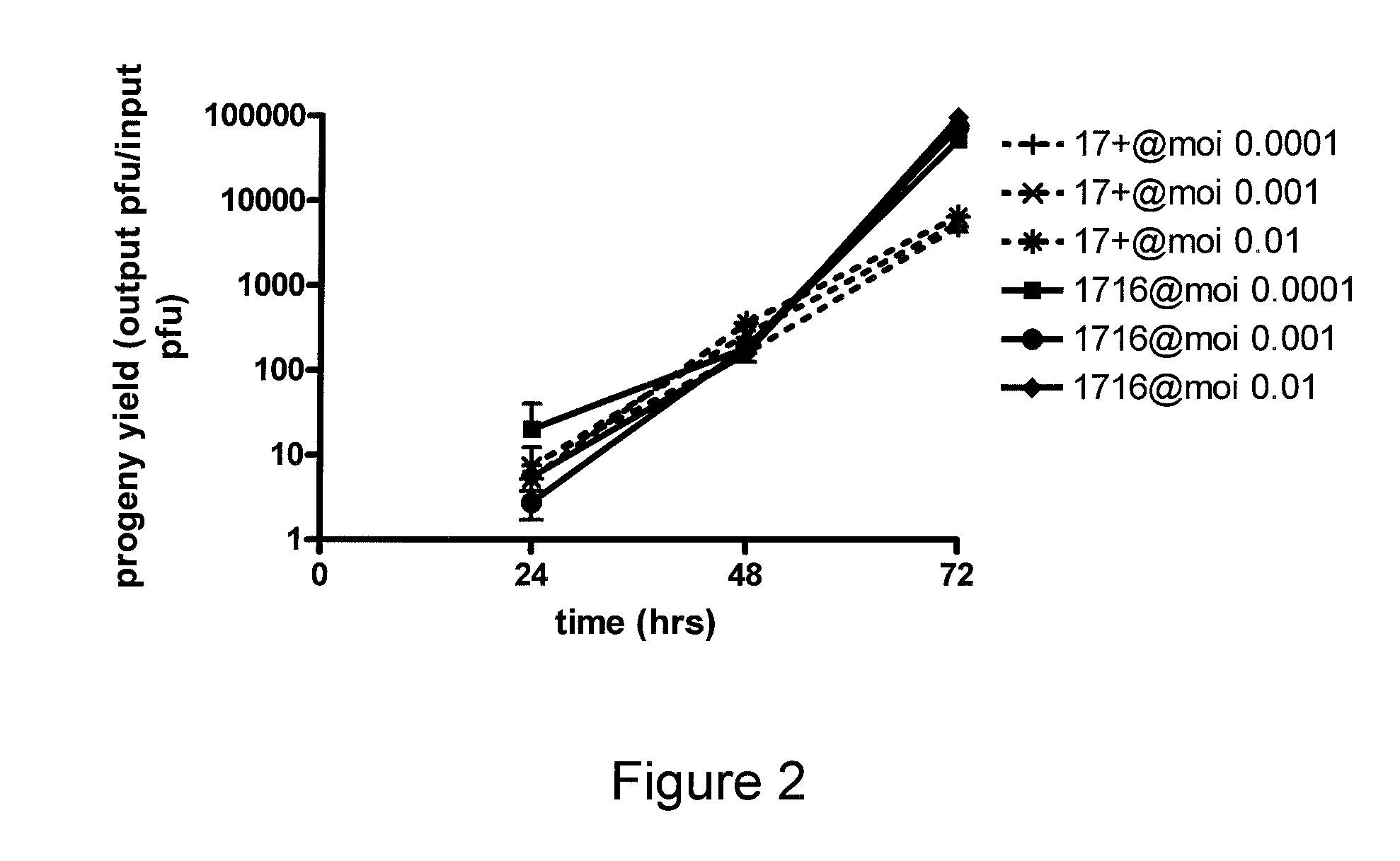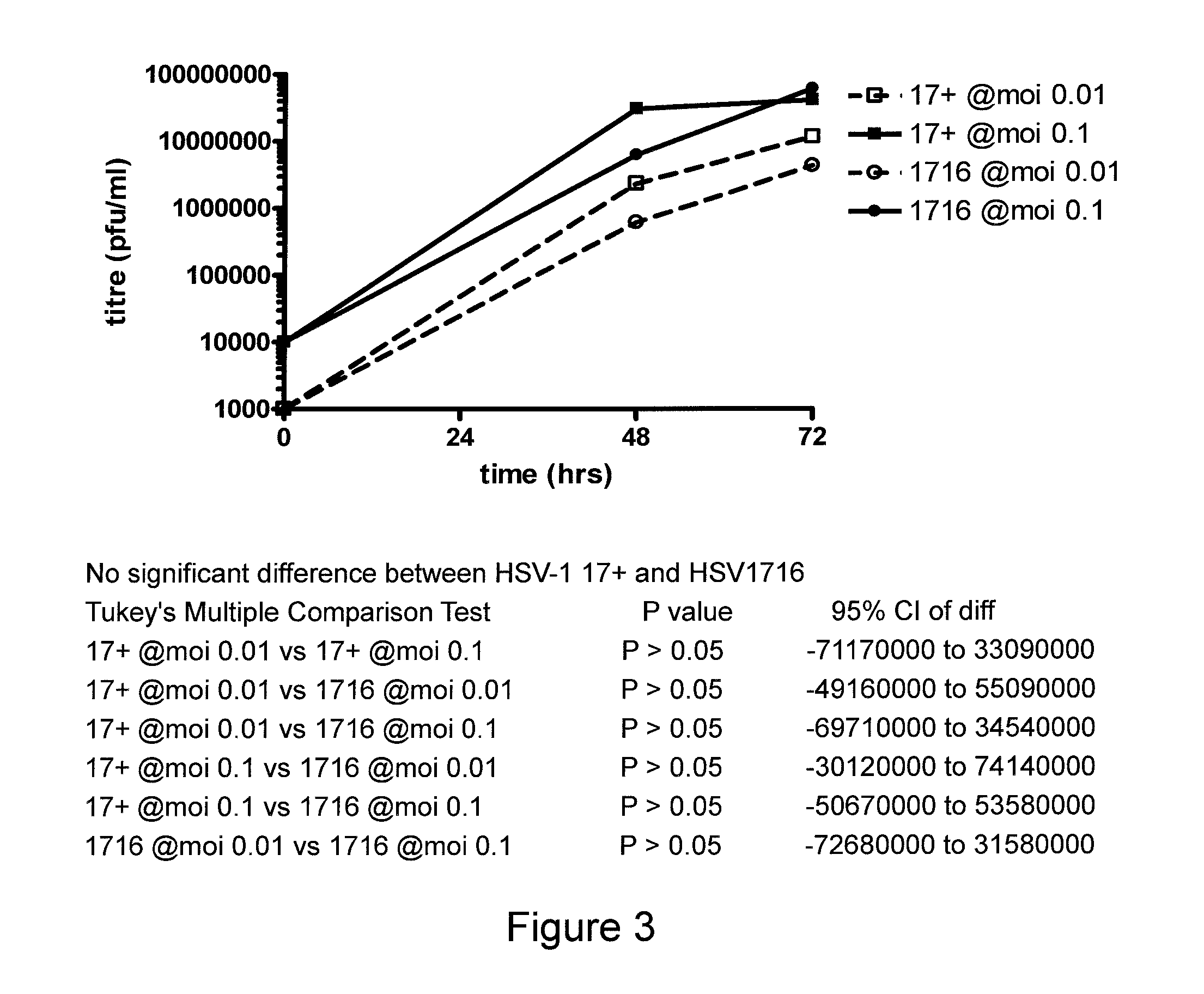Treatment of liver cancer
a liver cancer and treatment technology, applied in the field of liver cancer treatment, can solve the problems of poor prognosis of patients following diagnosis of hcc, limited procedure, and high incidence of tumor recurrence after surgical resection
- Summary
- Abstract
- Description
- Claims
- Application Information
AI Technical Summary
Benefits of technology
Problems solved by technology
Method used
Image
Examples
example 1
In Vitro Infection of HCC Lines with HSV1716
Hepatocellular Carcinoma Cells
[0173]HuH-7 is a well-differentiated, hepatocyte-derived cellular carcinoma cell line that was originally taken from a liver tumor in a 57-year-old Japanese male (Vecchi et al., Hepatology 2010 February; 51(2):654-9). HuH-7 are epithelial-like tumorigenic cells and are fully permissive for HSV1716.
[0174]The HepG2 cell line (ATCC No. HB-8065) was derived from the liver tissue of a fifteen year old male with differentiated hepatocellular carcinoma. HepG2 are adherent, epithelial-like cells growing as monolayers and in small aggregates. HepG2 are fully permissive for HSV1716.
[0175]HepG2-luc2 (Caliper HT1080-luc2) is a luciferase expressing cell line stably transfected with the firefly luciferase gene (luc2). The cell line was established by transducing lentivirus containing luciferase 2 gene under the control of human ubiquitin C promoter.
In Vitro HSV1716 Replication in HuH7 and HepG2-luc Cells
[0176]HSV1716 was f...
example 2
Replication Kinetics of HSV17+ and HSV1716 in Tumor Cell Lines
[0182]The following cell lines were used:[0183]Hepatocellular carcinoma (HCC): HuH7, HepG2-luc[0184]High Grade Glioma (HGG): U87[0185]Malignant Pleural Mesothelioma (MPM): SPC111[0186]Ovarian cancer: SKOV3[0187]Squamous cell carcinoma (SCC): A431
1) HuH7 (JCRB0403)
[0188]HuH-7 is a well-differentiated, hepatocyte-derived cellular carcinoma cell line that was originally taken from a liver tumor in a 57-year-old Japanese male. HuH-7 are epithelial-like tumorigenic cells which are able to form subcutaneous xenografts in nude mice.
[0189]According to their entry in COSMIC HuH7 cells have mutated FAM123B and TP53 genes. HuH7 cells readily form subcutaneous xenografts in nude mice.
2) HepG2-luc (Caliper HT1080-luc2)
[0190]The Hep G2 cell line was isolated from a liver biopsy of a male Caucasian aged 15 years, with a well differentiated hepatocellular carcinoma. The cells secrete a variety of major plasma proteins e.g. albumin, alpha...
example 3
Demonstration of HSV1716 Efficacy in a Hepatocellular Carcinoma Xenograft Model in Nude Mice
HuH-7 Xenografts—Biodistribution of HSV1716
[0203]HuH-7 cells were implanted subcutaneously in nude mice and allowed to form subcutaneous tumors. Subcutaneous tumors developed in 10 / 10 mice. All animal procedures were performed under license from the UK Home Office. Female 6-8 week old athymic nude mice (Charles River Labs, Tranent, UK) were maintained under specific pathogen free conditions and all animal experiments were performed according to the appropriate UK guidelines.
[0204]1×107 pfu HSV1716 was administered to all mice via a single tail vein injection.
[0205]Tumors / organs were harvested on days 1, 4, 7, 14 and 21 post-administration (n=2) and biodistribution of virus was analysed by titration.
[0206]HSV1716 was found to be almost exclusively localised to tumor tissue with high titres present throughout all samples. Most other tissues / organs were found to be free of virus at all times tes...
PUM
| Property | Measurement | Unit |
|---|---|---|
| time | aaaaa | aaaaa |
| diameters | aaaaa | aaaaa |
| infection time points | aaaaa | aaaaa |
Abstract
Description
Claims
Application Information
 Login to View More
Login to View More - R&D
- Intellectual Property
- Life Sciences
- Materials
- Tech Scout
- Unparalleled Data Quality
- Higher Quality Content
- 60% Fewer Hallucinations
Browse by: Latest US Patents, China's latest patents, Technical Efficacy Thesaurus, Application Domain, Technology Topic, Popular Technical Reports.
© 2025 PatSnap. All rights reserved.Legal|Privacy policy|Modern Slavery Act Transparency Statement|Sitemap|About US| Contact US: help@patsnap.com



